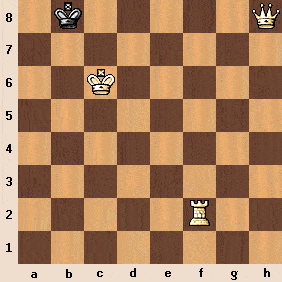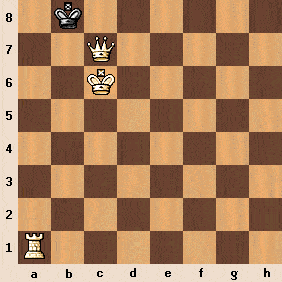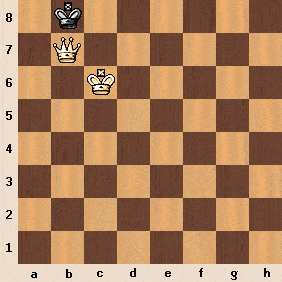Below is an example of a simple checkmate, and after the diagram is an explanation.
|
DIAGRAM OBJ-A Example of Simple Checkmate
|
[Note: If you are unfamiliar with the English Algebraic method of notation used in chess (the only official method of notation under FIDE’s Official Rules of Chess), you should first review the Chess Notation tutorial (link provided off the Main Chess – Index page). The basics of the method as well as symbols used in chess notation are also provided in tutorial, The Chess Set: The Chessboard, The Pieces, and The Pawns. The reason for doing so is to enable you to understand the description of the checkmate provided in the text following the diagram, set forth using English Algebraic and basic symbols used in notation. There are other notation types as well as symbols you will likely encounter (some more frequently than others) – including Standard Figurine Algebraic, Long Algebraic, Abbreviated Algebraic, German Algebraic, English Descriptive, Computer, Correspondence, and Portable Game Notation (pgn), as well as several older types. For reference, see the Notation and Symbols tutorials.]
In the simple checkmate example shown in the diagram above, assuming a basic knowledge of how the Kings, the Queen, and the Rook can move, as soon as the opposing King which is checkmated (Black in the example) became all alone on the chessboard (that is, had lost all his fighting units) it would be very obvious that checkmate was forthcoming assuming the White player did not make a very serious mistake, blunder. Equally true most likely (but not necessarily) would be that as soon as the opposing player (Black in the example) only had a couple or at most a few pieces and/or pawns left on the chessboard, an ensuing checkmate was a foregone conclusion.
Black’s King at b8 is under attack [check, noted by the plus sign symbol (+)]) by White’s Queen at h8 on Black’s back rank [the eighth (8th) rank]. Black’s King cannot move out of check by White’s Queen to square at a7 [Black’s second (2nd) rank; row numbered 7] or to a8 [in Black’s back rank] because White’s Rook at a1 would immediately attack and put Black’s King in check (a King cannot move to a square which would put the King in check). However, note should be made that control of a8 by White’s Rook is not important because White’s Queen also is in control of that square along Black’s back rank. Black’s King could not move to a8 and escape check by White’s Queen even if White’s Rook was not located at a1. Black’s King also cannot move off Black’s back rank to Black’s second rank (the 7th rank) to square b7 or square c7 to get out of check because White’s King at c6 is in control of those squares by blocking Black’s King from moving to one of those squares (an opposing King may not move to a square which is adjacent (touching at any point) the square upon which the player’s King is located). Finally, Black has no pieces or pawns to either capture White’s Queen or interpose between White’s Queen and Black’s King on the empty squares in Black’s back rank (squares c8 through g8) to block check by White’s Queen. Hence, Black King’s has been put into checkmate (noted by the # symbol), on the checkmate square, b8. Black is said to be checkmated and White wins (1-0).
In the simple checkmate diagrammed above, we see examples of a basic essential element for creating a mating net, and indeed in the game of chess as well for developing threats, developing attacks, and creating defensive alignment of pieces and/or pawns: controlling squares on the chessboard. Controlling a square occurs in three effective ways:
1.When a player’s piece or pawn is positioned either on a particular square or another square such that if an opposing piece or pawn moved or advanced to the particular square (and if the player’s has a piece or pawn on the square, the opposing player thereby captures it), a player has a piece or pawn which could capture that opposing piece or pawn safely (without it being subject to capture by the opposing player).
2.The player’s piece or pawn can capture the opposing piece or pawn in an advantageous trade of pieces (each capturing the same type of piece; e.g., a Bishop for a Bishop) or pawns (a pawn for a pawn), or an exchange of a pawn for a piece or a piece for a different opposing piece [Note: Under FIDE’s Official Rules of Chess, exchange is used to refer to a trade of equal pieces, or pieces of relatively equal value]
3.The player’s piece or pawn prevents the opposing King from moving to that square.
![]()
A related concept is when a piece or pawn is effectuating control of multiple squares…more than one square at the same time. In the above simple checkmate diagram, White’s Rook at a1 is controlling the entire a file (squares a1 through a8) and therefore prevents Black’s King from moving to a7 or a8 (the only two squares in the a file to which Black’s King possible could move as it can move only one square at a time). White’s King is in control of the b7 and c7 squares because being positioned on c6 White’s King prevents Black’s King from moving to b7 or c7. White’s Queen is in control of Black’s back rank (squares a8, b8, c8, d8, e8, f8, g8 and the h8 square upon which the White Queen is located; White’s Queen is in control of b8 because she has check (and checkmate) on Black’s King on that square, which is the checkmate square).
These concepts are developed more thoroughly later. In this introductory part, let’s carry this forward slightly on the concept of controlling squares in a mating net. In the above simple checkmate diagram, if White’s Rook was not located at a1 or on any of the squares a2 through a6, providing control of a7, then Black’s King would only be in check and not checkmated because Black’s King could move to a7. If White’s Queen were checking Black’s King from the c7 square, then control of a8 by White’s Rook would be necessary to effectuate the checkmate. In this later variation on the mating net pattern shown, control of a7 by White’s Rook would be unimportant because White’s Queen – while also checking and checkmating Black’s King – would control a7. Additionally, control of b7 by White’s King would be unimportant in this variation because White’s Queen also would be controlling that square. However, the power of White’s King to block movement by Black’s King is still important. The power of White’s King to provide defense and protection for White’s Queen in this variation becomes the central focus as a derivative from the power of White’s King to block Black’s King from capturing White’s Queen at c7. The following two diagrams depict the above variations.
|
DIAGRAM OBJ-A-1 No Checkmate
|
DIAGRAM OBJ-A-2 Example of Simple Checkmate First Variation
|
Let’s conclude this introduction to simple checkmates with another variation for simple checkmate, instead of White’s Queen at c7 lets place White’s Queen at b7. In this variation, White’s Rook does not even need to be on the chessboard at all, while White’s King’s power to block movement of Black’s King is still for defense and protection of White’s Queen, but not as to blocking Black’s King to move to the c7 square because White’s Queen would be providing control of c7. In this variation, White’s Queen does all the rest of the work: controls all six squares in the mating net pattern for the rectangular six-square anatomy of mate while checking and checkmating Black’s King.
|
DIAGRAM OBJ-A-3 Example of Simple Checkmate Variation Two
|
In learning chess, most chess coaches advocate the beginner learn as rapidly as possible to recognize the elemental patterns in simple checkmates as the foundation for developing basic <patterns for checking & checkmating (and avoiding being checked and/or checkmated), and also to reach one of the alternative objectives: drawing or stalemating (discussed further below).
Developing an appreciation for and understanding of the essential elemental concept, pattern recognition, is critical for learning and playing chess. Common sense dictates that a player hardly can be expected to play effectively moving pieces and advancing pawns unless he or she has a basic understanding of why this is being done and how to design a plan to accomplish reaching the prime objective…checkmate; or, one of the alternative objectives…drawing or stalemating. In the above diagram of a simple checkmate, the concept of pattern recognition is exhibited. The White player needs to understand how the Queen, King, and Rook can move, and how the Black King could respond, in order to force the Black King into position (through checks and controlling squares) so that White can checkmate.
These three basic concepts combine to form what I choose to call the Foundation for Playing Chess: Pattern Recognition, Developing a Plan, and Execution of the Plan (moving pieces and advancing pawns). This is the foundation around which these tutorials are structured and designed, to assist in developing pattern recognition in order to develop and execute a plan for winning the game. Let us turn to very basic rapid checkmates to further develop the concept of pattern recognition.




